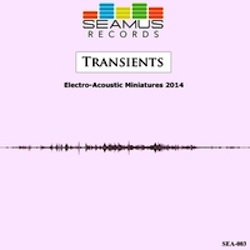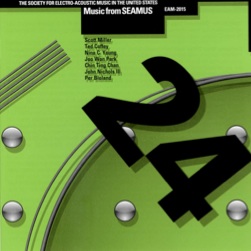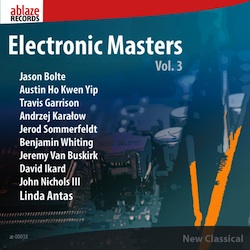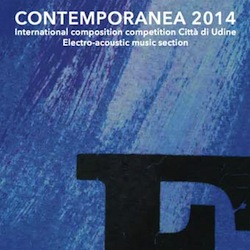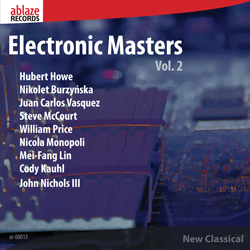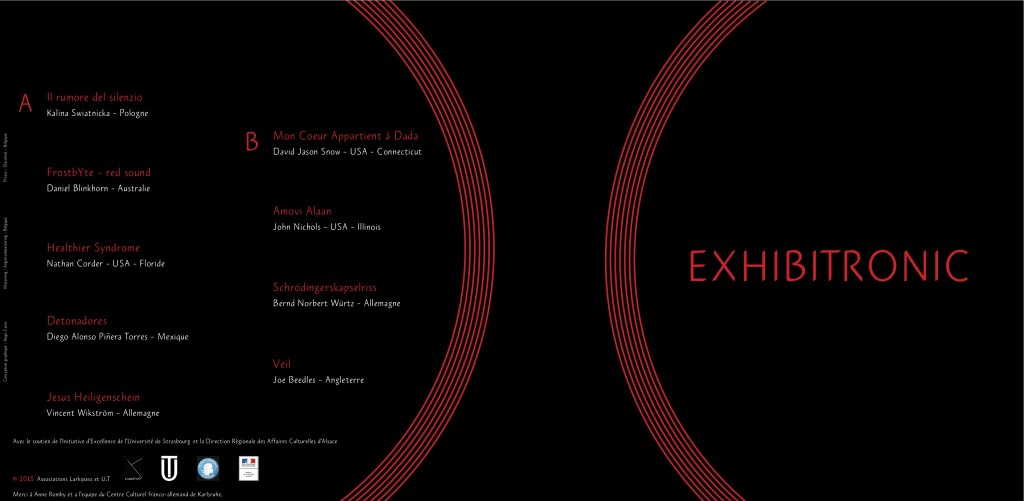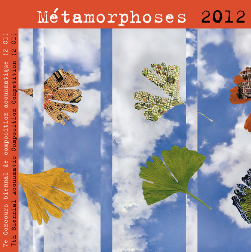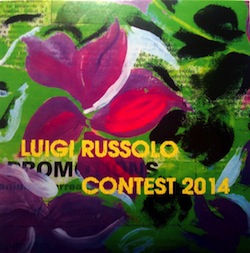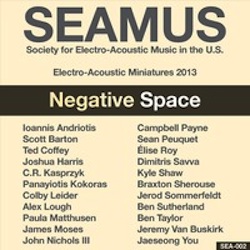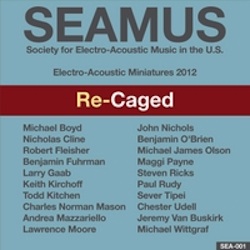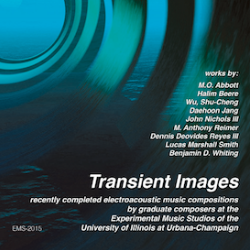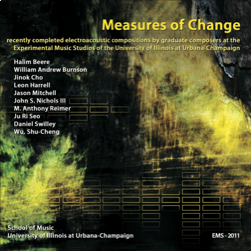Nothing That Breathes (Excerpt)
Included on the SEAMUS Volume 25 CD Recording, Nothing That Breathes was the 2015 SEAMUS Student Commission and was presented at “The Cube” at Virginia Tech. The composer is grateful to the many musicians (there are too many to mention here) that participated in studio recording sessions and thereby contributed to this composition. Nothing That Breathes was premiered on 122 discrete audio channels. Today’s form is available in 8-channel, and stereo.
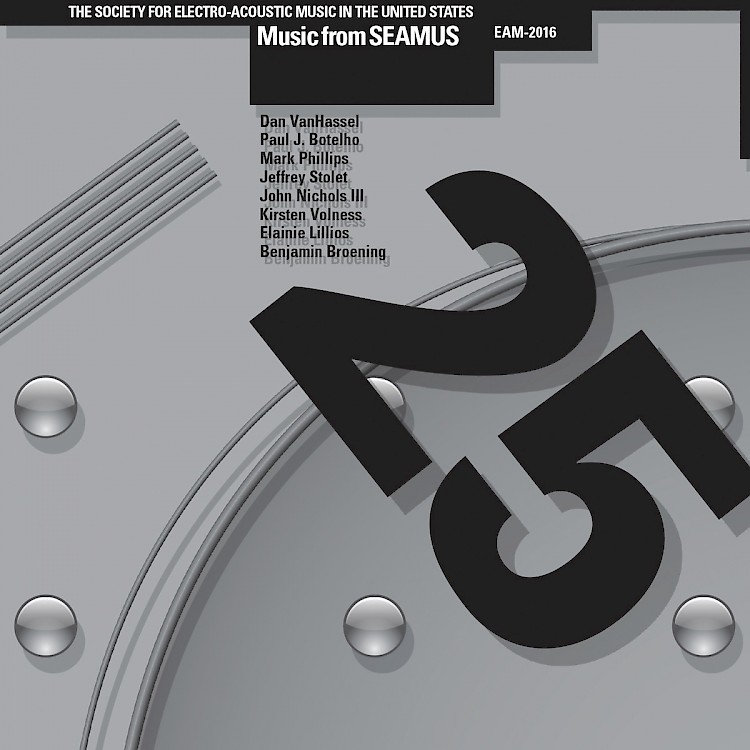
doyôgumo (Dog Days Clouds) (Excerpt)
Included on the SEAMUS Electro-Miniatures 2015: Sonic Haiku Recording, doyôgumo (Dog Days Clouds) refers to a Haiku written in 1814 by the esteemed Japanese poet, Kobayashi Issa:
.鬼と成り仏となるや土用雲
It becomes demon
and becomes Buddha
dog days clouds
(Translation by Kiyomitsu Odai and John Nichols III)
Reflecting the haiku’s sense of transition, liquid motion combined with evolving sonorities allude to the powerful, building clouds common in the dog days of summer. The midsummer clouds inspired Issa to compose this witty and effective Haiku, suggesting that both evil and good can be found in the same thing. The sounds of water were recorded at the Atlantic Center for the Arts in Fall 2014 with the special help of Brona Martin and Jonty Harrison. I am also thankful to Kiyomitsu Odai for his excellent rendering of Issa’s haiku.
South Gate (Excerpt)
Partly inspired by the prairie style of architecture innovated by Frank Lloyd Wright, “South Gate” conveys a sense of forward motion without return or recapitulation. Wright’s architectural masterpiece, the Robie House, for example, possesses a maze-like quality that suggests an entry point or opening that is not returned to. This element of the style brings to mind the book of Ezekiel, which reads, “he shall not return by way of the gate whereby he came in, but shall go forth over against it” (46:9). This passage refers to how the people are to enter and depart the inner court for sacred activity. Reflecting these influences, “South Gate” proceeds through a “path of discovery” to which it does not return. Geometric continuity is represented in repetition found at the conclusion of the work. Filtering acts as a means of achieving architecturally compressed and expanded space within the audible spectrum. The symbolism of a “gate” may be loosely interpreted as a passage from one place to another; however, the overt narrative connection that sonically emulates a typical creaking gate is overused, and therefore avoided in this electroacoustic aphorism. “South Gate” was completed in the Spring of 2015 and is included on “Electronic Master Vol.4” CD from Ablaze Records.
anicca
Anicca (2014) is the Buddhist doctrine of impermanence. Recognizing that everything consists of anicca is one of the first steps in the Buddhist path toward enlightenment and is one of the three basic facts of existence. The text, composed by Barry R. Morse and read by Halim Beere, epitomizes the human experience and the inherent condition of impermanence.
all we have are memories
forever
never again
lost to eternity
speak through the clouds
in my mind
forever
in my memory
(Barry R. Morse, 2014)
CLICK HERE and Download Electro-Miniatures Vol.3: Transients
GATES (Excerpt)
Completed in 2013, GATES is an electroacoustic composition that was partly inspired by the Pleiades constellation. A musical mapping of an image of the constellation occurs in the middle and at the conclusion of the composition. One can hear this depiction in the “wood block” timbres. This representation of Pleiades relates to a passage from Ignatius Loyola’s autobiography, St. Ignatius’ Own Story as Told to Luiz Gonzalez de Camara (1555).
It was his [Ignatius’] greatest consolation to gaze upon the heavens and stars, which he often did, and for long stretches at a time, because when doing so he felt within himself a powerful urge to be serving our Lord.
(From A Commentary on Saint Ignatius’ Rules for the Discernment Of Spirits, Jules J. Toner, 1979.)
I chanced upon this unique passage after an evening of stargazing. Initially, I did not think much of it, but re-evaluated the occasion after unintentionally opening to the following passage in Vladimir Solovyov’s essay, “Nationality from a Moral Point of View” (1895). … “the Spanish genius Ignatius Loyola founded the order of the Jesuits for the struggle with Protestantism on peaceful grounds” (Ed. & Trans. Wozniuk). Following this discovery, and seeing as it was one of two mentions of Ignatius in Solovyov’s entire collection of essays, I resolved to use the musical mapping of the constellation as a central and unifying element in this composition. The title refers to the use of noise gates during the creative process. Bending string and brass timbres, time stretched voice, and layers of filtered noise contribute to the drama of this composition. I am grateful for the assistance of the many musicians who participated in recording sessions that were utilized in this composition, and am especially thankful for the assistance of Chicago based musician, Tyler Beach, for his valuable insights and session performances on the acoustic and electric guitars.
CLICK HERE for Electronic Masters Vol.3
CLICK HERE for CONTEMPORANEA 2014
Amovi Alaan (Excerpt)
Composed in 2012, Amovi Alaan is an electroacoustic composition that utilizes additive synthesis components created with Digital Instrument for Sound Synthesis and Composition (DISSCO), recordings made in the University of Illinois Experimental Music Studios, and field recordings from Chicago.
The dream-inspired title is a reference to the following passage from Hartmann:
Apart from the conscious activity of certain individuals, phenomena are determined by the purposeful action of the spiritual principle, which is independent of any particular consciousness and which, in its inner power, infinitely surpasses any particular consciousness, and is therefore called the unconscious (das Unbewusste) or the superconscious (das Ueberbewusste).
(Philosophie des Unbewussten, Fifth Edition, by Eduard von Hartmann, quoted in Vladimir Solovyov’s “The Crisis of Western Philosophy” Chapter V, 1874)
My compositional intent is to make something musical, expressive, creative, and intriguing, while avoiding overt narrative connections. I wish to stimulate the listener’s imagination with diverse shapes, sensations, and surprises, as they voyage through this composition.
Download Amovi Alaan from iTunes or Amazon
AGE (Excerpts)
AGE (2012) involves the elimination of narrative connections between the compositional world and the sonic world by treating sound sources (field recordings, etc.) as “found templates” that serve as points of departure and influence the general direction, pacing and proportions of the resulting composition. The templates serve to map new concrete sounds onto abstract experiences so that diverse timbres may combine in unlikely ways and retain the flow of the original experience. Critical moments in the creative process indicate when to employ “surprise tactics.” Thematic foreshadowing and recall generate cohesion and anticipation as tension builds. Additionally, the theme of birdsong develops through the composition, focusing on a variety of calls from North American birds such as the Redwing Blackbird, Sora, Bittern, a variety of owls, and others. A special thank you is due to saxophonist Noah Even and horn player Stephen Burian for their very helpful session recordings.
Métamorphoses 2012 on electrocd.com
CLICK HERE for Luigi Russolo International Sound Art Competition 2014 CD
The Lot (Excerpt)
The human voice plays a significant role in this composition but it is not overbearing. In general, the vocal element progresses from occasional pure vocal tones, to extended vocal techniques, to processed voice. In each case, the voice is placed within varied sonic contexts. I am thankful for the many performers who contributed to this composition; in particular, the talents of lyric soprano Yoo Sun Na. I also wish to thank James Beauchamp for allowing me to record his Putney VCS3 and Sever Tipei for DISSCO/LASS/LASSIE; both were utilized as sound sources in this composition. Many of the sounds were recorded in the Experimental Music Studios directed by Scott Wyatt at UIUC.
Headbanger
Headbanger is inspired by the following John Cage quote:
I certainly had no feeling for harmony, and Schoenberg thought that that would make it impossible for me to write music. He said, ‘You’ll come to a wall you won’t be able to get through.’ So I said, ‘I’ll beat my head against that wall.’
Considering Cage’s influence on electroacoustic music, I felt it would be appropriate to make a reference to his first electroacoustic composition. Headbanger concludes with an allusion to the constant note record heard at the beginning of Imaginary Landscape No.1 (1939).
Download Headbanger from cdbaby.
Download Headbanger from iTunes.
The Pillar (Excerpts)
The Pillar from John Nichols III on Vimeo.
The Pillar at Gaudeamus Musiekweek
Composed in 2013, The Pillar is a 10-minute composition for amplified prepared Disklavier and electroacoustic sounds. The work utilizes text from the introduction of Vladimir Solovyov’s The Spiritual Foundations of Life (1885).
Initially, I became interested in Solovyov when considering the parallels between Scriabin’s and Solovyov’s conceptions of ‘all-unity’ and ‘wholeness.’ According to Solovyov,
Perfect all-unity, according to its very conception, requires full equilibrium, equality of worth, and equality of rights between one and all, between the whole and the parts, between the common and the individual.
He also wrote,
In general, the meaning of human love is the justification and redemption of individuality through the sacrifice of egoism.
(Meaning of Love, 1894, ed./trans. Vladimir Wozniuk)
These passages influenced the composition’s balance between the conventional piano and prepared piano timbres. My method involved implementing a primary and ancillary gamut (scale). In the primary gamut, certain pitches were fixed in a certain register. The remaining pitches were initially sieved out. They made up the ancillary gamut; four preparation techniques were applied to these pitches. For instance, muting the strings with non-stick putty, weaving small coins between the strings, weaving thin guitar picks through the strings, and weaving paper through the strings. Owing to Solovyov’s strong theological system, I felt it appropriate to name the composition after information gathered from an inflected practice of bibliomancy [= “foretelling the future by choosing a randomly chosen passage of a book, especially the bible”, OED]. The Pillar is a reference to ‘the pillar of cloud’ mentioned in Deuteronomy. Finally, I wish to thank Tatiana Shustova for her beautiful rendering of Solovyov’s text.
University of Illinois, Urbana-Champaign, Experimental Music Studios, Transient Images
The Ways
100 Years of The Art Of Noise from Monochrome Vision
Ol’ Grandaddy
University of Illinois, Urbana-Champaign, Experimental Music Studios, Measures of Change


